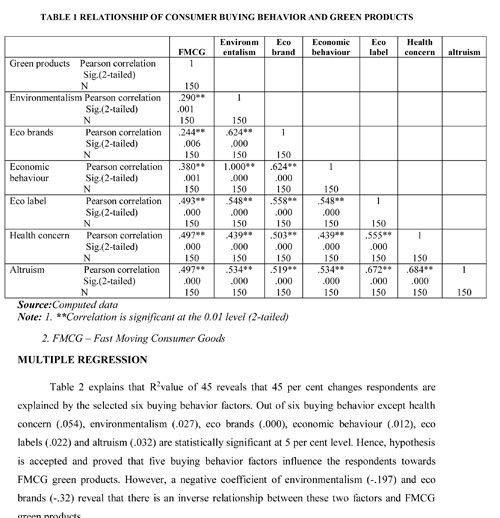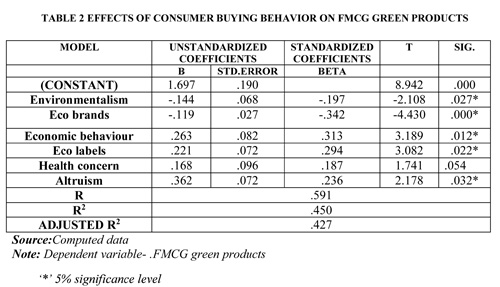Subscribe now to get notified about IU Jharkhand journal updates!
Impact of consumers’ buying decision on green products
Abstract :
Now-a-days, the term green products are a prevalent and most alluring word. Consumers have become conscious, and have been more environmentally friendly, not just for the many brands and their perceived consistency. Therefore, organizations have adopted green marketing. The research is based on five considerations such as environmentalism, conservation friendliness, economic behavior, affordability of products and the respect for wellbeing, the aim of this paper is to analyze the impact of green products on consumer buying behavior. A sample of 150 have selected on the basis of non-probability convenience sampling method. Data were analyzed through correlation and regression.
Keywords :
Consumer behavior, environment, factors and green products.1. Introduction
In late 1980s and early 1990s, the term environmental marketing was used (popularly called green marketing). It started with the identification of particular goods as hazardous to the earth's atmosphere. New green products have therefore been launched that have reduced environmental damage. The main area of interest for the public and for the government is environmental conservation.An individual's ecological behaviour is socially dependent. The growth of public awareness and international environmental awareness of the goods has enabled the marketer to make the consumers aware of the green commodity. Today, companies have created environmentally conscious goods and innovation to get them to the consumer and consumers are ready to pay for such products that benefit the environment.
REVIEW OF LITERATURE
Yogita Sharma1 (2011) Explained that the effective green marketing requires using good marketing principles to make green products acceptable to consumers. Green products require renewable and recyclable material, which is costlier and is not affordable by an ordinary man. The green marketing should nevermore be viewed as just one more attachment to approaching marketing but has to be continued with such high strength, as it has both environmental and social dimensions. Corporate must perform the consumer awareness by transmitting the message among consumers about the benefits of environmental-friendly products and services.
Aysel Boztepe2 (2012) described that the leading one of these problems is environmental problems that affect all living beings negatively. This study aims to give information about the effect of green marketing on customers. Data were collected from 540 consumers in Istanbul. The results of the analysis is environmental awareness, green product features, green promotion activities and green price affect green purchasing behaviours of the consumers in positive way.
Hans, Et al.,3 (2012) highlighted that the consumers’ concern for environmental issues has gradually increased over the past three decades appealing to preserve nature and biodiversity. The aim of this paper is to assessing the variables of consumers green purchasing behaviour. This conceptual paper suggests a framework integrating the so far incoherent frameworks as proposed by previous authors. In fact from the proposed integrated framework in total eight vital factors of green issues are likely to have an impact on consumer green purchasing behaviour.
Babita Saini4 (2013) described that green marketing is going to be proactive topic with it steps into the world of the consumers where consumers are not only aware for the multiple brands. The aim of the study is how consumer buying behaviour is affected by the green marketing. Data were collected from 100 consumers. The results from this illustrates that companies need to increase their communication with the customers for going green and that attributes like price and quality are more important than environment responsibility.
Adeep Dames5 (2014) described that the producing and selecting environmentally markets essentially understanding of environmentally friendly is required to be integrated into the corporate culture. The aim of this paper is to investigate the impact of green product on consumer purchasing behaviour. Data were collected and analyzed through regression analysis. This study potentially contributes to knowledge by examining the impact of green product on customer purchasing behaviour within technological companies.
Nazari, Elmira, et al.,6 (2015) stated that there is a direct and positive relation among the “green brand image”, “green brand trusting and satisfaction”, “perceived quality of the green brand”, loyalty to the green brand”, and “ awareness of the green brand”. Therefore, it is true to say that the green brand image is positively and indirectly in relation with the perceived quality of the green brand, the loyalty to the green brand, and the awareness of the green brand via the green brand satisfaction and trusting. According to the results, the main hypothesis of the research related to the significant relation among the brand image, the green trust, the green satisfaction, and the components of the green brand equity.
Meghna and Prachi7 (2016) highlighted that green is the word of the day. Companies and consumers know the importance of the environment to degrade it. This paper identifies those variables and the effect of each on consumers’ green buying behaviour. This study is based on the secondary data. Finding reveals that the prices of the green products should be kept at an economical level so that even an average income earner can also afford them.
Ibrahim and Meryem8(2017) highlighted that it is important to protect our environment while satisfying the needs of consumers with an ever- increasing variety of products and services. In order to realize the potential benefits of green marketing efforts, it is important to understand which factors affect the consumers purchasing behavior of green products. Data were collected from 410 consumers in Turkey and analyzed through t test, ANOVA and regression. Thus results revealed that the factors environmentalism, behaving economically and knowledge have significant on green purchasing behavior.
Arminda doPaço, Chris Shiel &Helena Alves9 (2018). Several green consumer behaviour models have sought to explain the relationship between green attitudes and individual behaviours interrelating with green consumption based on traditional theories. Nevertheless, there have been difficulties in developing an optimum or even a consensual model able to predict green consumer behaviour. This paper thus seeks to examine the links between a set of constructs in order to propose a model for green consumer behaviour based on a different set of buying behaviour antecedents: a pro social attitude, the value placed on green and green communication. We developed a survey, in a self-administered questionnaire format, to gather data before applying Structural Equation Modelling (SEM) for the analysis. The results returned convey how general prosocial attitudes have a direct influence on green consumption values, and that green values positively influence green buying behaviour and receptivity to green advertising.
Hameed, Irfan. et. al.10 (2019). Sustainability of the environment has become pivotal in the modern world, and there have been enormous efforts by the world leaders and organizations to reduce the effects of hazardous production on the environment. This has led companies to implement pro-environment programs and work on sustainability to shift consumption from conventional products to green products. The data for the study was collected from 300 respondents through purposive sampling from Karachi,the metropolitan city of Pakistan. Structural equation model (SEM) was applied to test the proposed hypotheses. The results of SEM indicate that all paths in the model are significant, except the path from attitude towards green products to eco-conscious behavior. The results also indicate that intrinsic religious orientation has no moderating effect on the green trust and attitude towards green products. This study contributes to understand the effects of new constructs in the theory of planned behaviour and their relationship with other variables in the model.
Keni, Keni, et. al.11 (2020). This research aims to examine whether 1) green perceived value and green perceived risk can influence green trust 2) green perceived value and green perceived risk can influence green purchase intention 3) green trust can influence green purchase intention 4) green trust mediates the effect on green perceived value and a green perceived risk on green purchase intention Sample was selected using convenience sampling method amounted to 150 respondents at Jakarta. Data was processed with structural equation modelling using SmartPLS.3.2.7 program. The results indicate green perceived value and green perceived risk have significant effect to predict green trust and green purchase intention, green trust have significant influence to predict green purchase intention, and green trust partially mediates the effect on green perceived value as well as green perceived risk on green purchase intention.
STATEMENT OF THE PROBLEM
The current scenario shows clearly that over the last two decades all political society, companies and organizations have been affected by environmental issues worldwide. Consumers have been pushed to take an interest in environmental protection and environmental issues. Customers are also supporting companies that run environmentally conscious. In view of the danger of global warming that leads to a catastrophe, green marketing is highly significant, rather than an anomaly or merely a fade. The scientist then concentrated on green goods in Tirunelveli taluk in terms of their effect on the purchasing habits of consumers.
METHODOLOGY
This study is based on both primary and secondary data. Primary data which were collected from 150 selected respondents using convenience sampling method through well structured questionnaire.
CORRELATION
Correlation analysis is used to find whether there is any relationship between the two variables. Table 1 explains that the all the six buying factors such as environmentalism (.290), eco brands (.244), economic behavior (.380), eco label (.493), health concern (.497) and altruism (.497) are significantly positively correlated at 0.01 level. Hence, it is proved that there is a significant relationship between FMCG green products and all selected buying behavior factors viz., environmentalism, eco brands, economic behavior, eco label, health concern and altruism.

 SUGGESTION AND CONCLUSION
SUGGESTION AND CONCLUSION
It is scientifically shown that all purchasing behaviour except health issues have an effect on the purchasing preferences of respondents with regard to green goods, such as environmentalism, eco brands, economic behavior, eco-labels and altruism. These purchasing considerations are adopted by the marketer and the consumer's demographic profile may also be focused as the goods are offered to the community to enhance sales of the FMCG green products. The population profile and computational components are not taken into consideration by most advertisers because it makes a huge difference for the unbeatable adoption of green goods.
References
- Sharma, Y. (2011),changing consumer behaviour with respect to green marketing–a case study of consumer durables and retailing. International journal of multidisciplinary Research, 1(4), 152-162.
- Aysel Boztepe (2012), Green Marketing and its Impact on Consumer Buying Behaviour.European Journal of Economic and Political Studies, 5, 5-21.
- Hans Ruediger, Mohammad Fateh and Yianna (2012), Factors Affecting Consumers’ Green Purchasing Behaviour: An Integrated Conceptual Framework. Amfiteatru Economic, XIV, 51-69.
- Bing Zhu (2013), The Impact of Green Advertising on Consumer Purchase Intension of Green Products.World Review of Business Research,3, 72-80.
- Adeeb and Dames (2014), The Impact of Green Product on the Customer Purchasing Behaviour: An Analytical Study on a Sample of the Technological Companies at Amman.Global Journal of Management and Business Research: E Marketing, 14, 26-32.
- Nazari, E., Ghasemi, B., &Saeidi, S. S. (2015), Explain the relationship between green brand image, green satisfaction and green trust and factors affecting on green brand equity. Bulletin of the Georgian National Academy of Sciences, 9(1).
- Meghna Sharma and Prachi Trivedi (2016), Various Green Marketing Variables and their Effects on Consumers’ Buying Behaviour for Green Products.IJLTEMAS, V, 1-8.
- Ibrahim Halil Seyrek and Meryem Gul (2017),Factors affecting green purchasing behavior: A study of Turkish consumers. International Journal of Academic Research in Business and Social Sciences, 7(1), 306-319.
- Arminda doPaço, Chris Shiel, Helena Alves(2018). A New Model for Testing Green Consumer Behaviour, Journal of Cleaner Production, https://doi.org/10.1016/j.jclepro.2018.10.105.
- Hameed, Irfan. et. al.(2019),Predicting eco-conscious consumer behavior using theory of plannedbehavior in Pakistan. Environmental Science and Pollution Research. https://doi.org/10.1007/s11356-019-04967-9
- Keni, Keni, et. al.(2020), Factors Influencing Green Purchase Intention. Advances in Social Science, Education and Humanities Research, 478.
